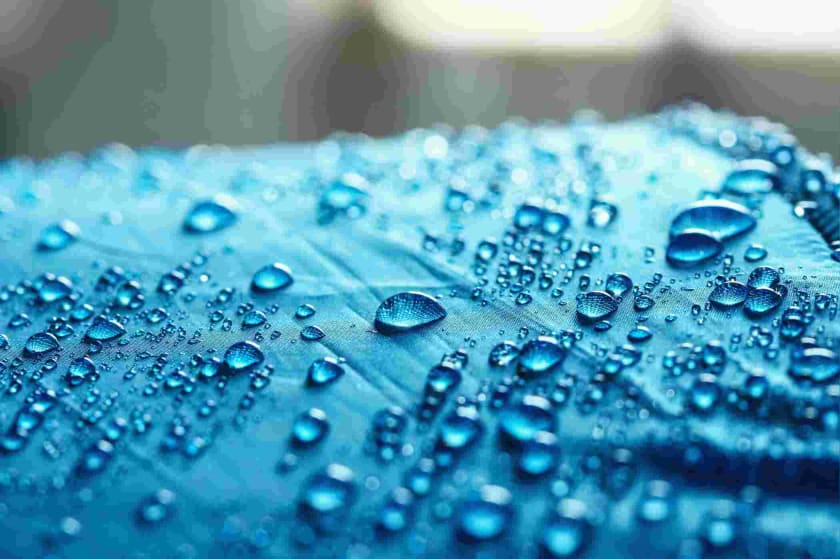Waterproof Fabrics : Types, Significance, and History



| Fabric | Waterproof Fabric |
| Types | Latex or Natural Rubber, Gore-Tex, Vinyl, Fluoropolymer Fabrics |
| Major Exporter | - |
| Used For | Jackets, raincoats, shoes, purses, and wallets, bags, oilcloth, tablecloth, etc |
| Thread Count | - |
| Breathability | Medium to High |
Waterproof fabrics are designed for garments meant to offer protection from natural factors like rain and wind. The invention of waterproof fabric can be seen as an advancement in technology with humanity in mind. Breathable waterproof fabric is a high-class textile that guarantees both comfort and effectiveness. Therefore the main function of waterproof fabric can be summed up in the following words: breathability, insulation, water resistance, and warmth.
About the waterproof fabric
Waterproof fabrics are those which are inherently or have been treated to become, resistant to water absorption or being moist. The fabric is usually natural or synthetic that is laminated to or coated with waterproof materials like rubber, polyvinyl chloride (PVC), polyurethane (PU), silicone elastomer, fluoropolymers, and wax. Treatment of the fabric to make it waterproof can be done during or after the manufacture. Waterproofing spray is also a used method.
History of Waterproof fabric
The waterproof fabric was invented by a Scottish chemist called Charles Macintosh. His experiment with naphtha led to the invention of waterproof fabric. Centuries of research and invention led to the further development of waterproof fabric. Gore-Tex waterproof fabric is a lightweight fabric invented by American WL Gore and Associates. Gore-Tex fabric is thin, durable, breathable, and windproof.
Significance of Waterproof Fabric in our lives
The name of the fabric itself speaks for its importance. The waterproof fabric comes in handy in harsh weather conditions like heavy rainfall or thunderstorms. Water can damage many fabrics hence waterproof fabric is necessary as an overcoat to protect from getting wet. Besides, the fabric is widely used in military, aerospace, and medical aspects. Breathable waterproof jackets and coats are very fashionable. Waterproof fabric is also resistant to mold and mildew growth. The durability of these fabrics is excellent. It is resistant to wear and tear and there is no concern about washing, drying, and shrinkage.

Uses of waterproof fabric
Besides jackets, overcoats, and raincoats, other uses of the waterproof fabric are mattress/pillow protectors, kites,, outdoor bunting, lunch bags, snack pouches, tote bags, tablecloths, picnic cloth, baby bibs, changing baby bags, windbreaker jackets, ponchos, etc. Various sportswear requires waterproof fabrics. Waterproof shoes are very popular throughout the year.
A List of Waterproof Fabrics
1. Latex or Natural Rubber is an elastic hydrocarbon polymer, was initially used for rubbing off pencil marks. Latex is a very stretchy, stress-resistant material that has many uses. It is popular for use in certain types of clothing, and many companies manufacture latex clothing today.
2. Gore-Tex is a fabric that is both waterproof and breathable. It has been used in medical implants, wire insulation, and fabrics. Gore-Tex is effective at keeping out moisture and is popular for use in all-weather jackets and clothing for outdoor enthusiasts. The clothing has pores to enhance its breathability
3. Vinyl is a synthetic compound material, a type of plastic derived from ethylene and chlorine. It is short for polyvinyl chloride resin. It is usually waterproof, strong and durable and comes in a variety of colors.
4. Fluoropolymer Fabrics are coated with fluoropolymers. The substance is resistant to heat and chemicals and provides insulation from electrical charges. It is also non-stick and typically transparent. Factories often use fluoropolymers in protective garments to protect workers from chemicals.

The season for Waterproof Fabrics
Waterproof fabrics are available all year round due to their various applications. The jackets and raincoats are much in demand during the rainy season. Oilcloth is one of the best waterproof fabrics.
Waterproofing and Environment
Waterproof fabrics often lead to environmental pollution, especially when they are made from synthetic fabrics. Waterproof fabrics usually have polymers in their composition which, besides corrupting the environment, accumulates in our body tissues as well. Several polyester materials are involved in the making of waterproofing fabrics which, again, are non-biodegradable in nature. Materials used in the manufacture of waterproof fabrics include membranes and durable water repellent (DWR) finishes. But, many of these, notably perfluorinated and polyfluorinated compounds (PFCs), are associated with chemicals considered harmful to human health and the environment. Therefore, there has been a significant rise of a plea for the companies to use membranes and DWR finishes made using safer chemicals. The ISO certifies the strength and resistance of water-repellent fabrics. Oeko-Tex certification is available if the fabric is safe and sustainable.



















